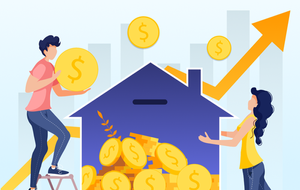The real estate market across Long Island and the State of New York has been booming over the last two years. Prices have skyrocketed and intense bidding wars have ensued. While this has been great for sellers, buyers are growing increasingly apprehensive about the future of the market. Even the youngest homebuyers are old enough to vividly remember 2008 when the housing market crashed 40% leading to the subsequent economic crisis.
It's understandable why consumers are cautious. On the surface, the current housing market may resemble the conditions leading up to the 2008 crash in many ways. Rumors are beginning to circulate that the Long Island housing market is in a bubble that could burst at any moment. However, leading real estate experts across New York (and the nation) feel confident that there is no housing crisis in sight. It’s important for prospective buyers to understand the unique differences between 2008 and today’s market.
Why Are People Concerned About a Repeat of 2008?
The 2008 housing crisis caused widespread financial damage to millions of homeowners as people were unable to pay their mortgages and defaulted on their loans. With the wound less than 20 years old, buyers are still on edge. Two key factors are leading consumers to believe that a potential crisis is on the horizon — record-high housing prices and rising interest rates.
First, it’s true that home prices are rapidly rising. Just last year, communities in Nassau and Suffolk Counties and Queens saw home prices increase on average between 10% and 12%. This rate even outpaces the high rate of inflation that is being reported by the federal government. A similar pricing increase happened leading up to the 2008 crisis. Home prices rose until they reached unsustainable levels before everything came crashing down. Many consumers firmly believe the old adage “what goes up, must come down”.
Due to the pandemic and supply chain issues, inflation is also surging. In January, the government announced that inflation reached 7.5% (between January 2021 and January 2022), a 40-year high. Because of this, it's likely that the Federal Reserve will soon take steps to help slow inflation rates by increasing interest rates. Many buyers believe that higher interest rates coupled with steep list prices will cause demand to disappear. With no demand, home prices would indeed fall.
Why 2022 is Not on Track to Become Another 2008
When the dust settled following the Housing Crash of 2008, the factors that led to the crash were apparent. It ultimately was a culmination of rising unemployment rates which reduced demand, high inventory levels as a result of both existing supply and a booming construction industry, and a large number of high-risk borrowers. With these characteristics in mind, it becomes clear that 2022 is very different from 2008.
Regulations Have Changed
The single most impactful factor that contributed to the 2008 housing crisis was poor lending practices by institutions like Freddie Mac and Fannie Mae. These organizations used predatory lending practices to make home loans available to subprime borrowers (those who had bad credit history and a higher risk of defaulting on their loans). At the time, banks rarely bothered to validate the borrower’s income levels allowing people to become over-leveraged.
In 2010, the federal government took action by instituting the Dodd-Frank Act. This act overhauled the regulations of the financial industry and changed the ways banks could approach lending practices for homebuyers. In 2018, Congress passed legislation to alter Dodd-Frank. Narratives from certain politicians have led many consumers to believe that housing market protections are no longer in place. This is untrue. While some changes were made, much of the core framework of Dodd-Frank is still in effect. Loans continue to be much more regulated and are scrutinized more closely than pre-2008.
Low Unemployment Rates on Long Island
Unemployment rates are significantly different this year compared to 2008. In the year leading up to the housing crisis, unemployment rose sharply from 4.5% to over 7%. Aside from unemployment as a result of the COVID-19 pandemic, more Americans are working with the unemployment rate currently around 4%. From a national perspective, many economists are projecting that unemployment will remain steady or even fall slightly to as low as 3.5% during 2022.
According to the New York State Department of Labor, Long Island has fared even better, ending 2021 with an unemployment rate of only 2.6%, the lowest unemployment rate since 1998. Unless a catastrophic event occurs, it’s not likely that an unemployed workforce will influence the 2022 Long Island housing market.
Reduced Inventory Levels
Inventory levels have changed drastically from what we saw prior to the 2008 crash. As unemployment rose, more people listed their homes for sale. In addition, many new homes (over 14 million) had been constructed between 2000 and 2009, more than any other 10 year period in US history. In the decade following the crash, new home construction fell more than 50%. While the Northeastern United States currently leads the pack in new home construction (a 27.5% increase), these levels have not returned to what we saw in the early 2000s.
Inventory levels are expected to stay low. In 2021, the number of homes listed for sale in Nassau and Suffolk counties was only 25% of the levels seen a decade earlier. These levels are reassuring consumers that we aren’t in the same type of bubble as 2008. As long as inventory remains low, pricing will continue to be inflated and prop up the housing market.
New York Residents Are Experiencing Increased Wages
While home prices are surging, so are wages. The Great Resignation of 2021 which saw 4.5 million Americans leaving their jobs is expected to continue through 2022. This means that companies must be more competitive in order to retain workers. According to Time Magazine, workers that changed jobs during the Great Resignation saw on average an 8% bump in pay, slightly outpacing inflation. Even minimum wage workers across Long Island are seeing a bump in pay (to $15 an hour) for the third consecutive year.
Increased wages are allowing consumers to be unfazed by the rising home prices with many expected to continue buying in 2022. For those who are apprehensive, increased wages mean that people are likely saving more money. In the event that prices do decrease, there will be plenty of sideline buyers ready to scoop up the cheaper properties, further stabilizing the price and market.
Head Into 2022 With Confidence
Since a housing crash is extremely unlikely, real estate professionals are urging consumers to stay in the market. The Lenard Team has years of experience servicing the Suffolk, Nassau, and Queens, New York areas. Our team can help you better understand market trends and conditions to feel confident that you are making the right real estate decisions for your family. Let's work together to navigate the 2022 housing market together.









